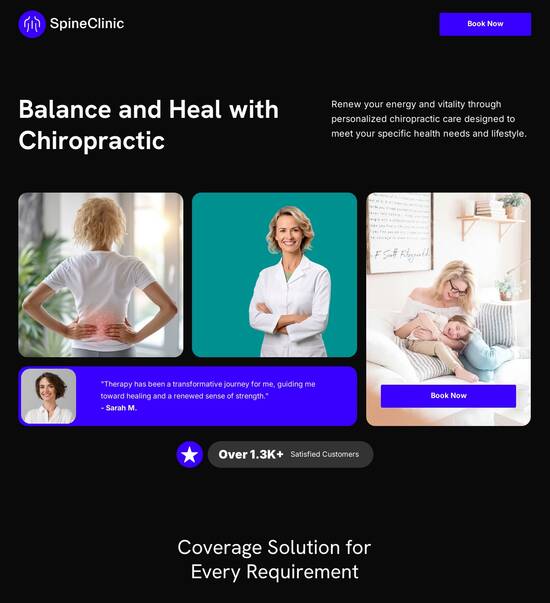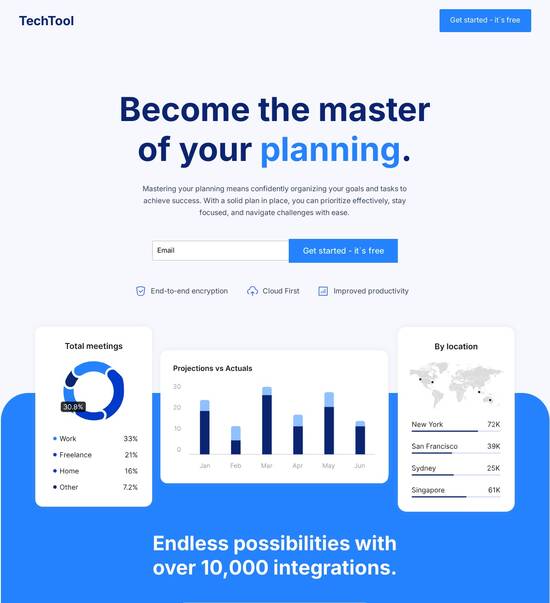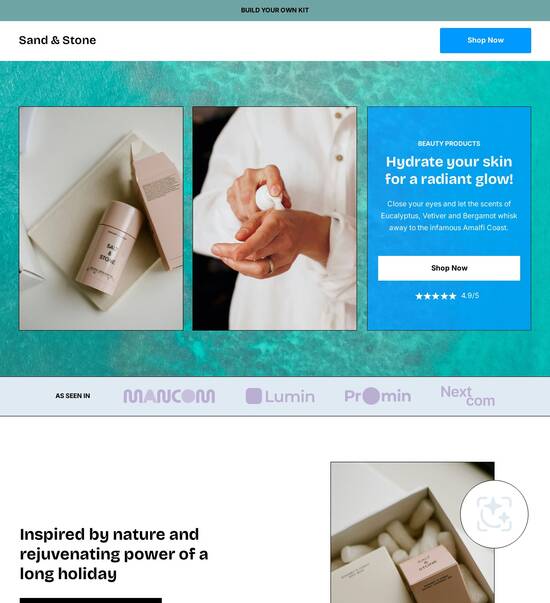
Next.js optimized terms of service page template
Explore Similar TemplatesAbout template
Supercharge your terms of service page with Next.js for outstanding performance! Learn more today.
Recommended templates

Easy to build without coding
With the intuitive drag-and-drop builder, anyone on your team can create high-converting pages without any knowledge of code or design. Make enhancements to your landing page with custom widgets using Javascript, HTML/CSS, or third-party scripts.

Multiple layouts for any industry and goal
Select from 500+ landing page layouts built to boost conversions across industry-specific scenarios. Customize them by adjusting fonts, adding images, and generating on-brand content with the AI assistant. Quickly scale with Instablocks® and Global Blocks that you can save, reuse, and update globally.

Loads fast and looks polished on any device
Every template is responsive, which means they present professionally on any device and load blazingly fast with our Thor Render Engine. You can also power them up with Google AMP technology to deliver an unparalleled mobile experience and drive higher conversions.

Robust analytics & experimentation
Get real-time updates and reporting across all your devices, showing the number of visitors, conversions, cost-per-visitor, and cost-per-lead. Launch AI-powered experiments, run A/B tests, and use heatmaps to analyze user behavior, then optimize your landing page to maximize conversions.







Easy to build without coding
With the intuitive drag-and-drop builder, anyone on your team can create high-converting pages without any knowledge of code or design. Make enhancements to your landing page with custom widgets using Javascript, HTML/CSS, or third-party scripts.
Multiple layouts for any industry and goal
Select from 500+ landing page layouts built to boost conversions across industry-specific scenarios. Customize them by adjusting fonts, adding images, and generating on-brand content with the AI assistant. Quickly scale with Instablocks® and Global Blocks that you can save, reuse, and update globally.
Loads fast and looks polished on any device
Every template is responsive, which means they present professionally on any device and load blazingly fast with our Thor Render Engine.
Robust analytics & experimentation
Get real-time updates and reporting across all your devices, showing the number of visitors, conversions, cost-per-visitor, and cost-per-lead. Launch AI-powered experiments, run A/B tests, and use heatmaps to analyze user behavior, then optimize your landing page to maximize conversions.
All the features you need to build how to write a terms of service
Explore more featuresLearn how to build terms of service examples
Frequently asked questions about nextjs service
Leading the way in building high-performing landing pages





Terms of service privacy policy: Your ultimate how-to guide
When it comes to boosting your digital marketing efforts, Instapage stands out with its robust capabilities for creating high-converting landing pages. This powerful platform empowers marketers to maximize their ROI through effective conversion rate optimization (CRO) strategies. With its user-friendly interface and extensive features, Instapage is designed to meet the diverse needs of marketers across various industries, including business services, education, and tech.
Step 1: Getting started with Instapage
The first step to leveraging Instapage is to create an account. Once you log in, you will have access to a vast library of over 100 high-converting templates. Users can easily customize these templates to fit their brand identity and marketing goals. Instapage’s intuitive builder enables marketers of all skill levels to launch compelling landing pages without the need for coding expertise.
- Choose a template: Select from various industry-specific options to find the perfect fit.
- Customize your page: Use the drag-and-drop editor to modify elements like text, images, and CTA buttons.
- Preview your changes: Ensure everything aligns with your vision before publishing your landing page.
Step 2: Optimizing for conversions
Optimizing your landing pages is crucial for achieving better conversion rates. Instapage provides several built-in experimentation features, including A/B testing and detailed heatmaps. This allows you to track visitor interactions and understand on-page behavior effectively.
- Conduct A/B tests: Compare different versions of your landing page to discover what resonates best with your audience.
- Utilize heatmaps: Identify which areas visitors engage with the most to optimize content placement.
- Analyze performance: Use Instapage’s analytics dashboard to evaluate your page’s effectiveness and make data-driven decisions.
Step 3: Personalizing your experience
Personalization is key to connecting with your target audience. Instapage enables you to create tailored experiences using dynamic text replacement and audience segmentation. You can deliver specific messages related to your ads, making your landing pages even more relevant to visitors.
- Dynamic text replacement: Adapt headlines and content based on the source of your traffic.
- Ad alignment: Use AdMaps to connect campaigns with corresponding landing pages seamlessly.
- Audience tracking: Leverage data tools to gain insights into different audience segments and tailor strategies accordingly.
With these foundational steps, you can effectively utilize Instapage to enhance the performance of your landing pages and increase your marketing ROI.
By focusing on high impact personalization, optimization strategies, and collaboration features, Instapage equips marketers with the tools necessary to excel in digital marketing.
Get started with Instapage today and transform your digital marketing campaigns into success stories with high-converting landing pages.
People also ask about Next.js optimized terms of service page template
Next.js optimized terms of service page template
Understanding the importance of terms of service (ToS) pages in web development
In the landscape of web development, terms of service (ToS) pages play a critical role. They serve as legal contracts between a business and its users, defining the parameters of usage for the services offered. A well-structured ToS page safeguards businesses against potential legal disputes, while also fostering a transparent relationship with users.
Establishing clear terms helps in setting user expectations, delineating what is acceptable behavior on the platform. This reduces the likelihood of misunderstandings, building a foundation of trust between the business and its clientele. By outlining both user rights and responsibilities, ToS pages ensure that users are informed about how their data will be handled and what behaviors are prohibited.
Legal protection for businesses
Establishing user expectations
Building trust with users
Additionally, regulatory considerations must be factored in when creating ToS pages. Compliance with local and international laws is not only a requirement but a moral obligation to users. For instance, the General Data Protection Regulation (GDPR) imposes specific rights upon individuals, and failure to comply can lead to substantial penalties. Thus, ensuring that ToS pages address user rights and obligations will ultimately benefit both parties involved.
Next.js: The framework behind next-level ToS page templates
Next.js is a powerful framework built on React, designed to enhance web applications through server-side rendering (SSR) and static site generation (SSG) capabilities. This combination allows for rapid page loads and optimized performance. For ToS pages, using Next.js ensures that the content is substantially more accessible and quicker for users to interact with, addressing a common frustration with traditional static documents.
One of the advantages of employing Next.js for ToS pages is its support for dynamic content rendering. As businesses evolve and regulations change, having a flexible structure with components that can be easily updated becomes essential. This dynamic capability aligns seamlessly with the evolving nature of legal language and user agreements, ensuring both accuracy and relevance.
Overview of server-side rendering
Static site generation capabilities
Advantages of using Next.js for ToS pages
Moreover, Next.js integrates numerous technologies that enhance functionality. With React at its core, developers can create reusable UI components, making customization straightforward. API routes can be used for fetching dynamic data, while CSS-in-JS libraries streamline the styling process, ensuring that the ToS page is not only functional but visually appealing.
Designing an optimized terms of service page template
A well-structured ToS template should include several key sections to be truly effective. Typically, the ToS should start with definitions and interpretations that clarify any legal jargon used within the document. Following this, it should outline user rights and responsibilities, providing clarity on what users can expect from the business and what is expected from them in return.
The limitation of liability clause is another essential component, protecting businesses from unforeseen issues that may arise in service delivery. The recommended layout should be straightforward and prioritize accessibility, allowing users of all abilities to comprehend the document. Mobile responsiveness is also crucial, as many users will likely access these documents from smartphones or tablets.
Key sections to include in a ToS page
Recommended layout style
Accessibility considerations
Customization features are vital for tailoring the ToS to specific business needs. With Next.js, businesses can create reusable components that cater to different industries. For instance, a tech company may need to include specific clauses related to software use, while an educational institution may focus on enrollment and student rights. Furthermore, offering multi-language support ensures a broader reach, making the ToS accessible to a diverse user base.
Enhancing user experience through innovative features
User experience is paramount when designing ToS pages, and Next.js offers features that can enhance readability and navigation. Adding advanced navigation solutions, such as a search functionality and a table of contents, can significantly ease the user experience. These features allow users to quickly find relevant sections, thus minimizing frustration and improving engagement with the document.
Moreover, integrating tools for user data collection can provide insights into how users interact with the ToS page. Utilizing analytics enables businesses to understand user behavior better, providing opportunities to refine ToS content based on actual user experience. Encouraging community feedback through surveys invites users to voice their concerns and suggestions, setting the stage for continuous improvement.
Advanced navigation solutions
Integrating user data collection
Collectives: community feedback mechanism
Syncing with location-based regulations
Creating ToS pages that are compliant with location-based regulations is essential. Different regions have specific legal obligations that must be met, depending on the nature of the business and service provided. Understanding how location affects these obligations will guide the creation of effective, location-specific templates that address the nuances of various jurisdictions.
Localized content strategies are crucial for tailoring ToS pages for specific populations. By adjusting language, examples, and highlighted local regulations, businesses can ensure that their ToS resonate with users. For example, if operating in a country with stringent privacy laws, organizations must emphasize how they handle personal data, establishing credibility and transparency.
Geographic considerations for ToS pages
Localized content strategies
Collaboration and team dynamics in developing ToS pages
Developing an optimized ToS page requires collaboration across multiple disciplines. Team roles typically include designers, developers, and legal advisors, each contributing their expertise to create a cohesive and comprehensive document. Effective communication within cross-functional teams is essential, as it helps to ensure that all perspectives are considered during the content creation process.
Maintaining a library of portfolio templates for consistency can streamline the process of creating ToS pages. This not only promotes uniformity across documents but also allows for easier updates through version control. Having a systematic approach to versioning ensures that the most current and legally compliant versions of ToS pages are always accessible, minimizing the risk of outdated content being presented to users.
Team roles for effective template development
Utilizing portfolio templates for consistency
The pre-launch phase and evaluation of the ToS template
Before launching a ToS template, it's crucial to preview its functionality. Testing user interactions through methodologies such as A/B testing can identify various content variations that might resonate differently with audiences. This iterative approach allows businesses to refine their ToS based on tangible feedback, leading to a document that is not just legally sound but user-friendly.
Creating a feedback loop prior to final launch can capture insights from both internal teams and external users. Encouraging feedback not only fosters an inclusive environment but also opens the door for continuous improvements based on user experiences. Engaging with stakeholders at this stage ensures the final product is well-rounded and effective at communicating necessary legal information.
Previewing template functionality
Feedback loop before final launch
Addressing common questions about ToS pages
Both users and developers often have questions regarding ToS pages. For users, understanding what a ToS agreement entails is essential. Knowledge of their rights and responsibilities can empower users, reducing feelings of vulnerability when engaging with digital platforms. It’s also important to clarify common misconceptions about the legal content; a transparent approach helps demystify what can often seem like convoluted legalese.
Developers, on the other hand, may require guidance on best practices for maintaining legal compliance. Staying updated on current laws and regulations is a continuous process that affects the content of ToS pages. Moreover, learning how to effectively manage updates and revisions as business needs evolve is vital to ensuring that ToS pages remain relevant and legally binding.
Frequently asked questions by users
Developer FAQs
Future trends in terms of service page development
The landscape of legal pages continues to evolve as user expectations shift. Users are increasingly prioritizing transparency and accessibility when it comes to legal documentation. There is a noteworthy trend toward simplifying the language used in ToS pages, enabling users to better understand their agreements. This evolution is a response to a growing demand for straightforward digital experiences.
As technology advances, businesses must anticipate changes that may impact the way ToS pages are designed and presented. For instance, the rise of artificial intelligence could pave the way for interactive ToS agreements that adapt to user behavior, providing a more personalized experience. Preparing for shifts in regulations, particularly around data privacy, will also be crucial for ensuring that ToS pages remain relevant and effective.
The evolution of legal pages in the digital landscape
Anticipating changes in technology and regulation
Final thoughts on leveraging Next.js for optimized ToS pages
In summary, the integration of Next.js into the development of optimized ToS pages can yield significant benefits for both businesses and users. By leveraging the platform's capabilities, developers can create efficient, user-centric designs that prioritize accessibility and maintainability. This ultimately leads to a positive user experience that upholds legal standards while also meeting user expectations.
The future of ToS pages lies in user-centered designs that foster trust and transparency. By investing time and resources into crafting effective legal documentation, businesses position themselves to enhance customer loyalty and drive conversions. The combination of Next.js and an optimized approach to ToS pages sets the stage for a digital experience that not only protects businesses but also prioritizes users’ rights and needs.
Recap of benefits
The future of ToS pages in user-centric web projects
Ready to skyrocket conversions?
Supercharge your ad campaigns with high-performing landing pages
Get started














